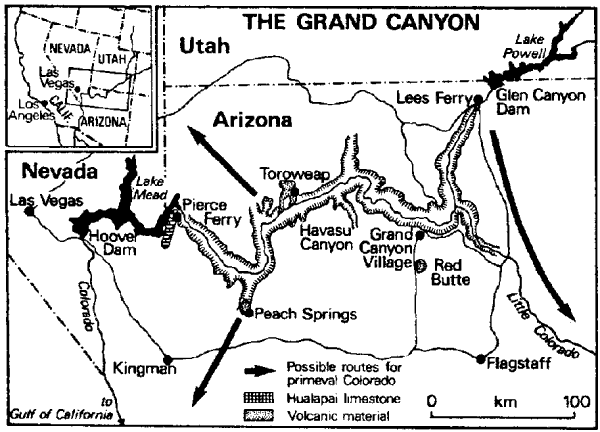 |
Science Frontiers ONLINE No. 37: Jan-Feb 1985 |
|
|
The Grand Canyon Conundrum
The Grand Canyon is really "grander" than that which meets the eye when standing on its rim. The immensity of the total excavation job can be appreciated by a trip to Red Butte near the southern rim. This conical hill rises 300 meters and is capped by the remnants of a lava flow, which has a radioisotope date of 9 million years. Thus, in the last 9 million years not only has the entire gorge of the Grand Canyon been cut but also a much greater volume of rock 300 meters thick adjacent to the present north and south rims.
The immensity of the volume of sediment removed is not the real issue. The first problem emerges downstream from Red Butte at Pierce Ferry. There we find 200 meters of Hualapai limestone, which has been dated at 8.7 million years from a thin layer of volcanic ash within the limestone. When this limestone was laid down, the geology is emphatic that no large, sediment-carrying river was in the vicinity. Most geologists agree that the lower end of the Grand Canyon was not active around this time. No one knows where the Col-orado River was flowing at this period. Some say southwest from Peach Springs; others point to a northwest route into Utah. All the likely alternate routes face serious geological obstacles such as lava barriers.
What does seem certain is that the stock explanation of the formation of the Grand Canyon is incorrect. It was not steadily ground out, cutting everdeeper as the whole region was slowly elevated. Actually, geologists believe that the region stopped rising over 50 million years ago. Where, then, did the sediments from a 450-kilometer canyon and the wide areas surrounding its rims go? The present exit of the Colorado near Pierce Ferry was blocked until fairly recently while the Hualapai limestone was being deposited; and other routes don't look too promising.
(Rice, R.J.; "The Canyon Conundrum," Geographical Magazine, 55:288, 1983.)
Comment. Moral: beware of facile explanations. The data presented, in fact, make one wonder whether all of the erosion might have occurred quite recently (perhaps when the great submarine canyons were cut?), using the Colorado's present route.
Reference. More Grand Canyon puzzles are cataloged under ETV7 in Carolina Bays, Mima Mounds. To obtain a copy, visit: here.
